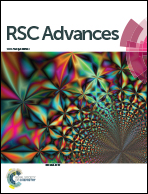A bluish-green emitting organic compound methyl 3-[(E)-(2-hydroxy-1-naphthyl)methylidene]carbazate: spectroscopic, thermal, fluorescence, antimicrobial and molecular docking studies†
Abstract
The present paper describes the physicochemical properties and biological activities of an organic single crystal, methyl 3-[(E)-(2-hydroxy-1-naphthyl)methylidene]carbazate which was grown by the slow evaporation solution growth technique. A powder X-ray diffraction study of the compound was carried out and the (hkl) values were found to be comparable with the reported values. The vibrational properties of the compound were analysed on the basis of FT-IR and FT-RAMAN spectra. The proton NMR spectrum was consistent with the chemical structure of the compound. From UV-VIS-DRS analysis and fluorescence studies, the absorption range and the bluish-green emission property of the title compound were found. The melting point of the compound was found to be at 205 °C from the TG-DTA-DSC analysis. The antimicrobial activities of the title compound were screened using the resazurin reduction assay against human pathogenic bacteria such as Shigella dysenteriae, Vibrio cholerae, Streptococcus faecalis, and Bacillus cereus and fungi such as Candida krusei, Candida albicans, and Candida glabrata. Molecular docking studies demonstrated that the title compound could bind well with the active site of human estrogen receptor and act as a potential inhibitor of ERα and ERβ.
![Graphical abstract: A bluish-green emitting organic compound methyl 3-[(E)-(2-hydroxy-1-naphthyl)methylidene]carbazate: spectroscopic, thermal, fluorescence, antimicrobial and molecular docking studies](/en/Image/Get?imageInfo.ImageType=GA&imageInfo.ImageIdentifier.ManuscriptID=C5RA04964D&imageInfo.ImageIdentifier.Year=2015)

 Please wait while we load your content...
Please wait while we load your content...